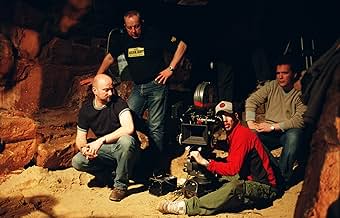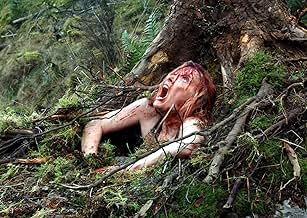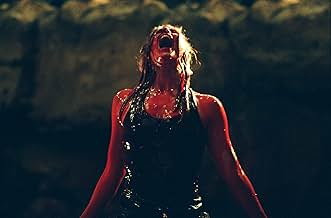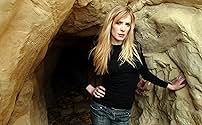A caving expedition goes horribly wrong, as the explorers become trapped and ultimately pursued by a strange breed of predators.A caving expedition goes horribly wrong, as the explorers become trapped and ultimately pursued by a strange breed of predators.A caving expedition goes horribly wrong, as the explorers become trapped and ultimately pursued by a strange breed of predators.
- Awards
- 8 wins & 22 nominations total
Stephen Lamb
- Crawler
- (as Steve Lamb)
- Director
- Writer
- All cast & crew
- Production, box office & more at IMDbPro
Storyline
Did you know
- TriviaThe scene where Sarah finds Beth barely clinging to life originally featured some "truly shit" dialogue, and the actors let that be known. Neil Marshall agreed, and the three went to a nearby pub the night before filming and rewrote the dialogue on a napkin. The film's producer chewed Marshall out for it, but he also agreed the scene was vastly improved now.
- GoofsAll of the spines in the various bone piles throughout the movie have the spines intact and the inter vertebral disks still present in the spines. Inter vertebral disks, however, are cartilage, not bone, and would have decayed (especially given that there is no clothing, hair, or fur in the bone piles, meaning that the bones are quite old). The spine segments should be scattered and in pieces, not in long segments.
- Crazy creditsThe creature's snarling sound can be heard at the end of the credits.
- Alternate versionsSPOILER: The endings of the US and UK versions differ. In the end, Sarah wakes up at the bottom of the cave, crawls out, and makes her way back to the car. When she is driving away, she pulls over and vomits, and when she leans back into the car, she is startled by the ghost of Juno sitting in the passenger seat. The US version cuts to the credits here. In the UK version, this apparition causes Sarah to wake up for real at the bottom of the cave, revealing her escape to be just a dream. She then has a vision of her daughter's birthday cake, which we see is just her torch. The camera backs out, the voices of the creatures can be heard again and are increasing in strength as they are closing in on her, and the movie ends. This ending was considered "too dark" for US audiences.
- ConnectionsEdited into The Descent: Deleted and Extended Scenes (2006)
Featured review
Regular readers of my comments know I am interested in cinematic architecture.
There's built space of course, but much cooler is when a filmmaker deals with the non-physical: architectural fire or water. Smoke.
And then there's perhaps the hardest of them, architectural darkness. Form of the formless, containment by absence, the pressing in of the absence of light.
"Ghosts of Mars" did a bit of it, poorly, and it is exceedingly rare overall. That's why I celebrate any attempt. This isn't great, but it has some competence and lessons.
If you don't know this little film, it has a long setup period where we have a group of young women not girls, surely who arrange to be stranded in a cavern with a threat.
There are monsters but the threat is the dark. This isn't terrific cinematic engineering, that part all seems to be hit and miss. But it does have terrific pacing overall and that attention to pacing extends to the use of darkness and the various lighting devices they have at their disposal.
Much use is made of the point of view nature of the lighting: flashlights and cameras and even after they are gone much of the blocking uses those sensibilities. Its a subtle fold, but so very effective. It makes us see what these women do and joins us to them in terror.
There's an effective plot device that pings off this. One of our women has visions, which we follow until we have our legs pulled out from us and her. The ending has one of these two endings where we aren't quite sure which is real and which imagined. The idea that both are true is the most unsettling.
Ted's Evaluation -- 3 of 3: Worth watching.
There's built space of course, but much cooler is when a filmmaker deals with the non-physical: architectural fire or water. Smoke.
And then there's perhaps the hardest of them, architectural darkness. Form of the formless, containment by absence, the pressing in of the absence of light.
"Ghosts of Mars" did a bit of it, poorly, and it is exceedingly rare overall. That's why I celebrate any attempt. This isn't great, but it has some competence and lessons.
If you don't know this little film, it has a long setup period where we have a group of young women not girls, surely who arrange to be stranded in a cavern with a threat.
There are monsters but the threat is the dark. This isn't terrific cinematic engineering, that part all seems to be hit and miss. But it does have terrific pacing overall and that attention to pacing extends to the use of darkness and the various lighting devices they have at their disposal.
Much use is made of the point of view nature of the lighting: flashlights and cameras and even after they are gone much of the blocking uses those sensibilities. Its a subtle fold, but so very effective. It makes us see what these women do and joins us to them in terror.
There's an effective plot device that pings off this. One of our women has visions, which we follow until we have our legs pulled out from us and her. The ending has one of these two endings where we aren't quite sure which is real and which imagined. The idea that both are true is the most unsettling.
Ted's Evaluation -- 3 of 3: Worth watching.
Details
- Release date
- Country of origin
- Official site
- Languages
- Also known as
- El descenso
- Filming locations
- Perth and Kinross, Scotland, UK(on location)
- Production companies
- See more company credits at IMDbPro
Box office
- Budget
- £3,500,000 (estimated)
- Gross US & Canada
- $26,024,456
- Opening weekend US & Canada
- $8,911,330
- Aug 6, 2006
- Gross worldwide
- $57,130,027
- Runtime1 hour 39 minutes
- Color
- Sound mix
- Aspect ratio
- 2.35 : 1
Contribute to this page
Suggest an edit or add missing content






























